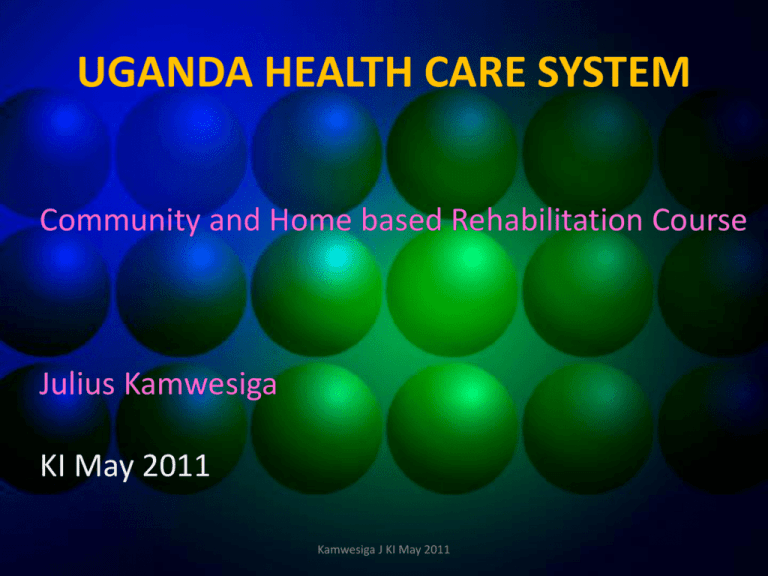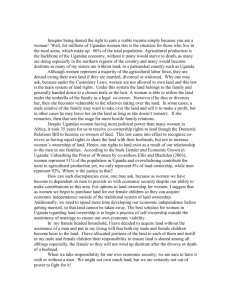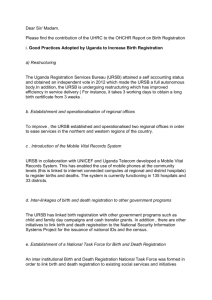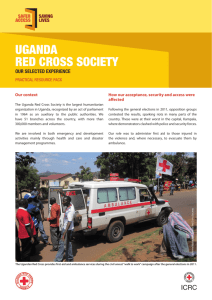Health care system in Uganda
advertisement

UGANDA HEALTH CARE SYSTEM Community and Home based Rehabilitation Course Julius Kamwesiga KI May 2011 Kamwesiga J KI May 2011 Objectives 1. Define a Health System 2. Describe how Ugandan Health care System is organized 3. Outline facts and figures of health care in Uganda 4. Describe the major health sector reforms 5. Outline major roles of rehabilitative health care in Uganda. 6. Describe the role of Government in CBR 7. List Uganda’s achievements in CBR 8. List the challenges Kamwesiga J KI May 2011 Location of Uganda in Africa Uganda Kamwesiga J KI May 2011 Location of Kampala City KAMPALA Kamwesiga J KI May 2011 A section of Kampala City Kamwesiga J KI May 2011 Demographic and Social economic Statistics • • • • • Population 32 Million Total Fertility rate (children per woman)7.1 Adult literacy rate 68.9% National per capita income (US $) 1520 Population living below poverty line 84.9 Kamwesiga J KI May 2011 Uganda’s population continues to grow rapidly… 120 100 81.4 80 53.7 60 36.8 40 20 2 2.5 2.8 3.6 5 6.5 9.5 12.6 16.7 22.0 24.7 0 19 00 19 11 19 21 19 31 19 48 19 59 19 69 19 80 19 91 20 00 20 02 20 15 20 25 20 40 20 50 Population (millions) 103 Year Kamwesiga J KI May 2011 Great Lakes Region Population Trends (2005-2050) Country Population in Millions 2005 2025 2050 Congo D.R 61.8 106.0 181.9 Sudan 40.2 61.3 84.9 Tanzania 37.9 59.8 88.3 Kenya 34.0 52.9 76.6 Uganda 27.6 54.8 103.2 Rwanda 8.1 13.1 23.7 Burundi 7.4 12.4 20.2 Total 217.0 360.3 587.8 Kamwesiga J KI May 2011 Life expectancy in selected African countries(1985-2010) (Source; US Census Bureau, May 2000) Figure 2: Life Expectancy in Selected African Countries(1985-2010) 65 Life Expectancy at Birth 60 55 50 Uganda 45 Zambia South Africa Zimbabwe 40 35 30 Botswana 25 20 1985 1990 1995 2000 Kamwesiga J KI May 2011 2005 2010 Uganda has a Rapid Population Growth Rate (3.4 % p.a.) Major factors (among others): •High fertility rate •Short birth intervals •High teenage pregnancies Kamwesiga J KI May 2011 Birth attended by skilled health personnel Kamwesiga J KI May 2011 Uganda: Demographic Characteristics • Total Population - 32 million • Population growth rate - 3.4% • Population doubling time - 21 years • HIV prevalence - 6.4% • Infant mortality rate - 76/1000 • Under-5 mortality rate - 157/1000 • Maternal mortality ratio - 435/100,000 • Life Expectancy - 50 years Kamwesiga J KI May 2011 Health status statistics Cause of death among children under 5 years of age (%) • Malaria 20.8% • Prenatal conditions 20.2% • Pneumonia 19% • Injuries 4.4% • Neonatal causes 24% • Othors 12.4% • HIV/AIDS 7.7% Kamwesiga J KI May 2011 Top ten causes of death in all ages • • • • • • • • HIV/AIDS Malaria Lower respiratory infections Diarrhoeal diseases Perinatal conditions Tuberculosis Cerebrovascular diseases Ischaemic heart disease Kamwesiga J KI May 2011 20% 12% 12% 9% 4% 4% 3% 3% The ratio of health workers to population The Ratio of health workers to Patients in Uganda • Doctor is 1:24,000 • Nurse is 1: 1,700 • Midwives 1: 9,000 • Dentists 1: 77,000 • Lab technician 1: 16,000 • Occupational Therapist 1: 433,000 • Env’tal health officer 1: 27,OOO Kamwesiga J KI May 2011 What is a Health System • Complex to define, however, a health system is taken to include “all activities whose primary purpose is to promote, restore or maintain Health” • This definition encompasses Health actions and Non-Health actions within and outside the Health Sector that lead to desired health results. Kamwesiga J KI May 2011 Ugandan Health care System • The Uganda’s health system, like other systems, aims to achieve and sustain good health for its people. • The Health system has been evolving over the last 3 to 4 decades to handle emerging concerns and challenges to the health situation in the country. • Health Care Delivery has mostly been through modern and Traditional practices. Kamwesiga J KI May 2011 Health Care Organization • • • • Public Sector Private Not For Profit (Faith Based) Private Medical Practice Traditional and Complementary – – – – Herbal medicine Traditional Birth Attendants Bone Setters Spiritual Healers • Community health workers/promoters/drug peddlers Kamwesiga J KI May 2011 Health Care Delivery • Health care delivery is done through a decentralized framework. The District health structure is responsible for all structures in the district except the Regional Referral Hospitals where they exist. Kamwesiga J KI May 2011 HOUSEHOLDS / COMMUNITIES / VILLAGES HC II HC II HC II HC II HC II HSD HC III HC III Referral Facility (Public or NGO) (HC IV or HOSPITAL) District Health Services HQ Regional Referral HOSPITALS National Referral HOSP MOH Headquarters Kamwesiga J KI May 2011 HC III District Health Services Uganda Health system cont’ • Village health teams/community medicine distributors The first contact for someone living in a rural area would be a medicine distributor or a member of a village health team (VHT). Each village is supposed to have these volunteers using bicycles. They still have no medicine, but they can advise patients and refer them to health centres. • Health centre II • According to the Ugandan government's health policy, every parish is supposed to have one of these centres. A health centre II facility, serving a few thousand people, should be able to treat common diseases like malaria. It is supposed to be led by an enrolled nurse, working with a midwife, It runs an out-patient clinic, treating common diseases and offering antenatal care. Kamwesiga J KI May 2011 Health centre III • This facility should be found in every sub-county in Uganda. These centres should have about 18 staff, led by a senior clinical officer, It should also have a functioning laboratory. Health centre IV/ District Hospital • This level of health facility serves a county. In addition to services found at health centre III, it should have wards for men, women, and children and should be able to admit patients. It should have a senior medical officer and another doctor as well as a theatre for carrying out emergency operations. Kamwesiga J KI May 2011 Regional Referral Hospital (RRH) • There are 10 RRH which should have all the services offered at a health centre IV, plus specialised clinics – such as those for mental health and dentistry – and consultant physicians. National Referral and Teaching Hospital • At the top of the healthcare chain is the national referral hospital. • This is where some of the best medical brains can be found, often working part-time at private clinics to supplement their meagre government salaries. Kamwesiga J KI May 2011 Mulago National referral hospital Makerere University Kamwesiga J KI May 2011 Surrounding slums Kamwesiga J KI May 2011 The Health sector reforms • Decentralization • Abolition of user fee. • Government partnering with Private not for profit organizations. • Working with private health care providers. • Encourage the autonomy of public Hospitals. • Planning and resource allocation system (bottom-up Vs Top-down practice). Kamwesiga J KI May 2011 HEALTH SECTOR REFORM CONT’S • Human resource management –Retrenchment –Pay reforms –Transparent remuneration structures –Decentralized human resource management Kamwesiga J KI May 2011 Health sector & the rehabilitation of PWDs in Uganda Rehabilitation of PWDs involves; • Medical Rehabilitation – treatment and counseling. • Special or Inclusive education. • Social economical rehabilitation through provision of vocational training and income generating projects. • Psychological support for self acceptance and realization. • Supporting and involving Disabled Peoples’ Organizations (DPO) in government development programmes. Kamwesiga J KI May 2011 • A Typical picture you can see while at one of the District Hospitals in Uganda Kamwesiga J KI May 2011 Ministry of Health guidelines and action plan on rehabilitation • Rehabilitation is one of the essential district health services. • Rehabilitation starts at health centre III where assessment is done and referral made. • Out reach clinics are organized to reach out for PWDS in the Districts. • District Hospital is the first level specialist rehabilitation services. Kamwesiga J KI May 2011 Role of Government in promoting CBR • Policy-making and planning • Putting in place appropriate administrative structures. • Provision of resources • Decentralization • Training personnel • Onward referral system, monitoring & evaluation. Kamwesiga J KI May 2011 Through CBR Uganda has achieved the following • PWDs in Uganda have been trained to appreciate and manage disabilities- thru accessibility to education facilities. • Local communities have contributed assistive devices and other appropriate resources to assist children in school access education opportunities • Local communities have been assisted to establish corrective surgery for their children. • Local communities have been empowered to identify children in need of special services. Kamwesiga J KI May 2011 Special needs education Kamwesiga J KI May 2011 Vocational Training for the blind Kamwesiga J KI May 2011 Challenges of CBR 1. 2. 3. 4. 5. 6. 7. 8. 9. Poverty Unreliability of community involvement Vs DPOs Gov’t denial of responsibility of services provision. Limited local resources poor infrastructure High level of illiteracy. Unequal opportunities Dependency Women with disabilities Sustainability is poor Kamwesiga J KI May 2011 Challenges cont 10.The Global Human Resource crisis hits Uganda hard. 11. Leadership, Management and Specialization are in short supply at all levels of health care. 12. A low Health Sector budget leaves many interventions unfulfilled. Kamwesiga J KI May 2011 Challenges cont’ 13. Investment in training is low 14. recruitment and retaining of staff is poor 15. deployment of staff is difficult 16. migration of health workers is on the rise 17. demoralization due to work overload is common. 18. Restrictions on recruitment and low salary packages´. Kamwesiga J KI May 2011 Poverty a challenge to CBR Kamwesiga J KI May 2011 Accessibility Challenge Kamwesiga J KI May 2011 KI May 2011 Narrow entrance & un evenKamwesiga floor Jfor wheel Chair Poverty and inadequate community infrastructure The Wheel chair does not enter the house Kamwesiga J KI May 2011 Thank you God bless Kamwesiga J KI May 2011








